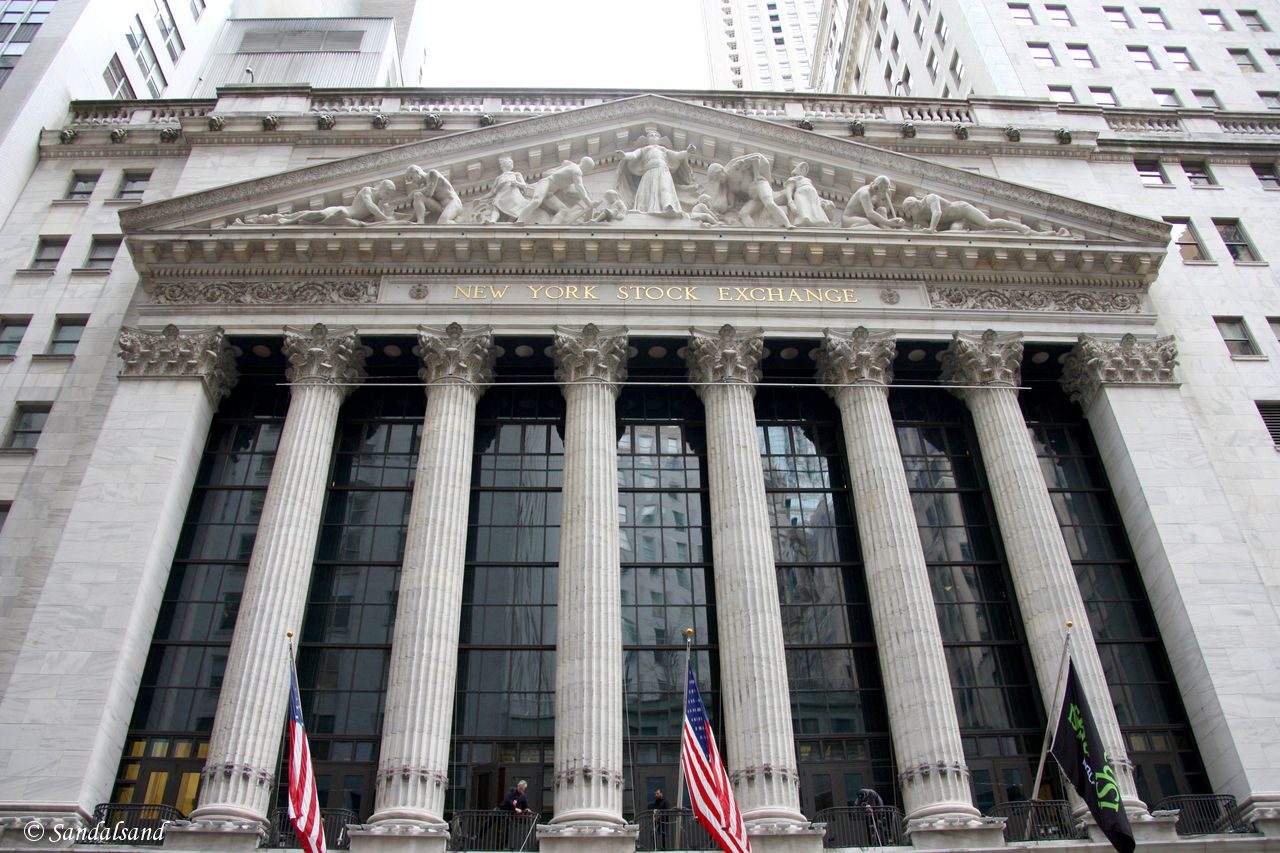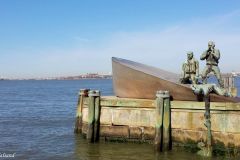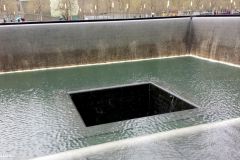We are going to Liberty Island, Ellis Island and the Financial District of New York. This is a full day in New York, filled with captivating things to see and significant lessons to be learned. There is no way you can avoid following in our footsteps.
Overall impressions
This do-it-yourself “tour” starts in Battery Park on the southern tip of Manhattan. Here we board a ferry for a visit to Liberty Island and then on to Ellis Island before returning. On foot we make our way up Manhattan’s Financial district to the 9/11 Memorial site.
The highlights
- Since 1886 the Statue of Liberty has served as a beacon of freedom and democracy for all. It is a World Heritage Site.
- From 1892 to 1954 around 12 million immigrants were taken through the halls of Ellis Island before they were let into the country, or returned home. Today, approximately 40% of all Americans can trace at least one of their ancestors back to this island.
- The Financial district on Manhattan is the world’s most important of its kind, and has been for decades.
- The 9/11 site will be a constant reminder of one of the world’s worst terror attacks.
This tour is so varied, and so fascinating, that it will captivate you for at least a full day.We spent three hours on Liberty Island, two hours on Ellis Island and finally two hours in the Financial District. You could do it in less, but the weather was nice and there was much to discover.
I will now present in text and images what we experienced. Towards the end of the article there is some practical advice on how to get to the islands. It involves some planning.
Battery Park
In New York’s early days there were artillery batteries placed here on Manhattan’s southern tip. Today it is a park with trees, lawns and squirrels. There are even beehives. The hives have been placed in recent years, but the bees were introduced by the first Europeans settling on Manhattan, the Dutch.
This 10 hectares public park is a nice place to start the day. The skyscrapers to the north lends a fine backdrop for the view out the harbour, towards where we are heading – the Liberty Island. We arrived one hour early for our scheduled ferry departure and spent it walking around in the park.
Apart from the flora and fauna the park is dedicated to memorials. The largest is the East Coast Memorial dedicated to the 4,609 U.S servicemen who died in the Atlantic Ocean during World War II. All names have been inscribed on eight large granite pylons. There is an eagle statue underlining it all.
The American Merchant Mariners’ Memorial bronze sculpture is situated on the other side of the big red-bricked battery structure. It is also about WW2, and it is a very strong monument depicting capsized sailors.
There is also a monument to the Universal Soldier, and a stone commemorating the 4000 sailors who died on Norwegian merchant ships sunk during WW2.
There are even more. But this is it for now. Let us board the ferry.
Liberty Island
Introduction
Read the practical advice later on in this article. After a security check we walked right onto the ferry and climbed up on the top floor. This is the best place to stand, weather permitting. You will not be alone, there are four million visitors to Liberty Island each year.
It is a short 10 minute voyage to the island. The ferry does a nice little circle around half the island before coming to a rest on the southern tip. This gives ample opportunity to capture images of Manhattan to the north, Ellis Island to the west, before turning your attention to the Statue of Liberty.
On the island
Once on the island you should pick up your audio guide and walk around the statue, before entering the museum and climb up on the viewing platform – providing your ticket covers the latter. In any case, this is the best way to explore the Statue of Liberty, by being on the island. Take your time and enjoy the view, towards Manhattan, New Jersey and up in the air.
Up is a long way. The Statue of Liberty measures 93 metres from top to toe, or more precisely from the torch to the ground. That includes the old 11-pointed star-shaped Fort Hood at the bottom (6 metres high), and a 27m granite pedestal set inside the former fort. The copper statue is 46 metres tall.
The statue
Liberty Enlightening the World, the official name of the statue, was a gift from the people of France to the United States. The statue was designed by the French sculptur Frédéric Auguste Bartholdi. The interior iron skeleton was designed by engineer Gustave Eiffel, famed for a particular tower in Paris, while the pedestal was drawn on the desk of American architect Richard Hunt.
The statue is made of copper from various sources, hammered in France in several pieces, and assembled here on the island. The statue depicts Libertas, a Roman goddess. She is holding a torch of freedom and a tablet with these letters and numbers: July IV MDCCLXXVI. (That is Latin for July 4th, 1776, the date of the American declaration of independence.). The goddess is depicted as in a mid-stride, with freed shackles at her feet.
Naturally this is a National Monument in the United States. In addition it is a UNESCO World Heritage Site. UNESCO writes: “She endures as a highly potent symbol – inspiring contemplation, debate, and protest – of ideals such as liberty, peace, human rights, abolition of slavery, democracy, and opportunity.”
Your ticket
Our ticket covered the viewing platform on top of the pedestal, but the view was not that much better up here. On the other hand we got closer to the feet of the goddess. The old torch is placed in the museum below the pedestal, a museum depicting the story behind the statue as well as the process of building the monument. Later efforts to preserve the monument are also explained.
To me it was with deep satisfaction that I set my feet on Liberty Island. This monument has been on my mind for ages. I have seen the statue so many times on film and in pictures, read about in books and on net. I am glad I went there – it’s such a powerful symbol, or as UNESCO writes a “masterpiece of the human spirit”.
Our next stop was Ellis Island, a place I can’t possibly understand why has not entered the World Heritage List.
Ellis Island
A look back in history
For half a century more than 12 million potential immigrants were registered on Ellis Island. They all had to wait patiently in line, in the Registry Room pictured below.
In 1903 New York received more than 700,000 prospective immigrants and was by far the most important point of entry to the United States. The second in line, Baltimore, received that year roughly 70,000 immigrants.
The island was originally quite small, but was over time increased almost tenfold by landfill. The main island holds the original Registry Room while the other parts (previous islands) were reserved for a hospital and contagious disease wards.
From importance to not so much
From the 1920s the importance diminished due to new regulations, the island was mostly used to detain immigration applicants before returning them to their homeland. By 1954 it was all history. After that the island fell into decay not to be restored until the 1980s. Today only the main building and surrounding park is open to the public, the rest may be visited on special tours.
If you walk through the building you will enter the lawn on the back and to your left find the The American Immigrant Wall of Honor. This wall contains the names of over 700,000 immigrants. See if you can find your own relatives.
Once there
Upon entering the main building you should pick up your audio-guide with a headset (like on Liberty Island) and follow the instructions. Very informative and very good. There are posters in the exhibition halls offering some information but the guide is essentially a must.
Most potential immigrants stayed on Ellis Island for a few hours only, but some where kept for several days and even months. The fear of letting persons with a psychic disorder into the country was telling, likewise with particular physical conditions, and even single women with no male relative waiting on the mainland.
In addition Ellis Island was for third-class passengers. The more affluent were swiftly checked through immigration procedures on the mainland. To us, this was the most surprising piece of information.
The Registry Hall and the other rooms in the same building must have been nerve wrecking. What if you failed the medical examination and legal requirements? Some (about 2%) were returned to their home countries, sometimes splitting families.
Financial District
First impressions
We returned to Battery Park on the southern tip of Manhattan. The buildings north of the park represent a tremendous view, from a distance. I would say that the Financial district is best seen from a distance. Being inside the rather narrow streets, for instance in Wall Street, does not offer the same awe-inspiring feeling.
Planning our visit we had pinpointed a few sights to visit. Read this.
We moved slowly in from Battery Park, where you should spend some time. Our first stop was Stone Street, one of the original streets from the Dutch era. There are a few other streets nearby. We were ambushed by rain and sough refuge inside an Irish bar. Murphy’s Tavern is the oldest building in this street. We were lucky in a double sense. Their service and beer was very good.
Backtracking a bit to a small park called Bowling Green we found the exciting Charging Bull at the northern end. This is in fact the beginning of Broadway, running north for most of Manhattan.
NYSE
The bull was in 1989 placed by the sculptor on the pavement outside the New York Stock Exchange, by surprise. It ended up here and has become an iconic, new landmark of New York City. Read the story behind this. The Charging Bull is a potent one, so take notice of how many visitors place their hands on the horns, and balls, of the bull – to have their picture taken.
Coming up next was NYSE, the Stock Exchange. Before arriving here I had this idea of getting inside. It had to be dropped.
Just a few metres up the road, at the intersection with the rather narrow little Wall Street, we found the Federal Hall. Like NYSE, we did not get inside but were left with admiring the steps and columns at the front. This was actually the place where the first president of the United States was sworn in. George Washington is of course placed on a statue outside the hall.
Next we turned our attention uphill on Wall Street, towards the Trinity Church at the far end, at the intersection with Broadway. A fine church it is, and as we entered a choir began preparing for Evensong. It was a lovely contrast to the high-rises outside.
9/11 Memorial Site
It was before nine in the morning in New York that the first aircraft crashed into the North Tower of the World Trade Center. Home in Norway, in the early afternoon a colleague had just opened CNN’s website to check out the latest news, and yelled that a passenger plane had hit the WTC. We all ran over to him to see what was going on, and in a few moments all rushed back to our own stations attempting to open CNN’s webpage. It became congested and we gathered at the work stations that had succeeded in getting a stable link.
Then, on live television, we saw the second aircraft crash into the South Tower. The rest is history.
The world has changed profoundly after this attack on the World Trade Center and the result of the two other hijacked airplanes. Because of this it was immensely emotional to be standing at the site were the twin towers once stood. The two huge pools now serving as a constant reminder of this horrendous terrorist attack, will forever be a reminder of what human madness is capable of doing, to civilians.
The worst terrorist attack in world history caused 2,606 casualties here at the World Trade Center. Their names have been inscribed on the top walls of the tow pools placed where the two towers once stood. In between there is a new museum documenting it all.
Unfortunately we arrived too late for a visit to the museum. We heard it was very good.
Practical advice for visiting the islands
The Statue of Liberty in the New York harbour is visible from land as well. Some would choose to take the free Staten Island ferry to get even closer to the statue. I would argue the best will be to book in advance the combination ticket to get ashore on Liberty Island and continue on to Ellis Island nearby.
The Statue Cruises is the only company allowed to operate a transportation service to the islands. They also operate out of New Jersey, but Battery Park on the southern tip of Manhattan was more convenient for us. We paid 18$ for the round-trip including access to the pedestal (i.e. directly beneath the copper statue) and free audio guides on both islands.
With a prebooked e-ticket you save valuable time in Battery Park, you skip the long queues and proceed straight to the security check. You may throw in 4 extra dollars for access to the crown, but the price is not the trouble – you will have to book four months in advance. Pedestal or crown access can not be bought on the island, it has to be booked previously or on land.
And some more
Let me just add that the price is the same for ferry alone (with audio-guide) as the pedestal access. The latter gives you the added benefit of the museum visit and today’s best exercise. To reach the top of the pedestal you climb 192 steps inside of it. If you are going to the crown you will have 354 steps before you reach the top, from the base. There are no elevators.
The audio guides are handheld and very useful. You may choose from nine languages. Just remember to get a headset when you pick up your player. Hang the player around your neck and be free to operate your camera as you make your way around the island.
There is a restaurant, bookstore, souvenir shop and restroom facilities on both islands.
Please beware that the ticket states a time for your departure. Once on Liberty Island you can spend as much time as you like before taking any ferry on to Ellis Island, and likewise back to Battery Park. Beware that operation stops some time in the afternoon so you should preferably have an early morning ticket. (The crowd seemed to be growing during the day.)
Sandalsand’s New York map
This described and mapped walk in the Financial District is 2 kilometres long. Walking the islands is easy peasy in terms of distance.
This article is part of a series from a week-long visit to New York City. We planned our visit by pinpointing on a map all attractions we wanted to visit, skipped some and connected the rest with walking routes.
The result is illustrated on this map. At first sight it seems immensely overcrowded. Fortunately you may zoom in, click the markers, hide specific walks, and even expand the map into a new tab or window.
Read more
(3) Liberty Island, Ellis Island and the Financial District
(4) The High Line, Greenwich Village and Flatiron
In addition, there is a special entry from New York’s own World Heritage Site, the Statue of Liberty.





